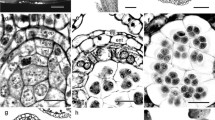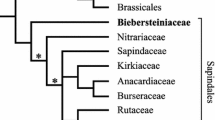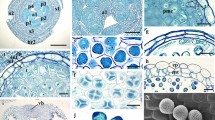Abstract
The affinities of Petrosavia, a rare, leafless, mycoheterotrophic genus composed of two species indigenous to East to Southeast Asia, have long been uncertain. However, recent molecular analyses show that the genus is sister to Japonolirion osense. Japonolirion and Petrosavia comprise the Petrosaviaceae, which are now placed in its own order, Petrosaviales, distinct from other monocots based on molecular analyses. We conducted an embryological study of Petrosavia, comparing it to Japonolirion, as well as to basal monocots (Acorus and Araceae) and more derived monocots (Nartheciaceae, Velloziaceae, and Triuridaceae). Our results showed that Petrosavia is very similar in embryology to Japonolirion, with both genera sharing a glandular anther tapetum, simultaneous cytokinesis in microspore mother cells, anatropous and crassinucellate ovules, T-shaped tetrads of megaspores, ab initio Cellular-type endosperm, and a mature seed coat composed of the exotesta, endotesta, and endotegmen. The two genera of Petrosaviaceae are clearly distinct from Acorus, and all Araceae, Nartheciaceae, Velloziaceae, and Triuridaceae genera in various combinations of characters. Thus, both molecular and embryological evidence support the distinctness of the Petrosaviaceae from other monocots and its placement in its own order, Petrosaviales.




Similar content being viewed by others
References
Barabé D, Lacroix C, Bruneau A, Archambault A, Gibernau M (2004) Floral development and phylogenetic position of Schismatoglottis (Araceae). Int J Plant Sci 165:173–189
Biddle JA (1979) Anther and pollen development in garden pea and cultivated lentil. Can J Bot 57:1883–1900
Browne ET Jr (1961) Morphological studies in Aletris. I. Development of the ovule, megaspores and megagametophyte of A. aurea and their connection with the systematics of the genus. Am J Bot 48:143–147
Buell MF (1935) Seed and seedling of Acorus calamus. Bot Gaz 96:758–765
Buell MF (1938) Embryogeny of Acorus calamus. Bot Gaz 99:556–568
Caddick LR, Rudall PJ, Wilkin P, Chase MW (2000) Yams and their allies: systematics of Dioscoreales. In: Wilson KL, Morrison DA (eds) Monocots: systematics and evolution, vol 1. CSIRO, Melbourne, pp 475–487
Cameron KM, Chase MW, Rudall PJ (2003) Recircumscription of the monocotyledonous family Petrosaviaceae to include Japonolirion. Brittonia 55:214–225
Chase MW, Soltis DE, Soltis PS, Rudall PJ, Fay MF, Hahn WH, Sullivan S, Joseph J, Givinish TJ, Systma KJ, Pires JC (2000) Higher-level systematics of the monocotyledons: an assessment of current knowledge and a new classification. In: Wilson KL, Morrison DA (eds) Monocots: systematics and evolution, vol 1. CSIRO, Melbourne, pp 3–16
Chase MW, Fay MF, Devey DS, Maurin O, Ronsted N, Davies TJ, Pillon Y, Petersen G, Seberg O, Tamura MN, Asmussen CB, Hilu K, Borsch T, Davis JI, Stevenson DW, Pires JC, Givnish TJ, Sytsma KJ, McPherson MA, Graham SW, Rai HS (2006) Multigene analyses of monocot relationships: a summary. Aliso 22:63–75
Corner EJH (1976) The seeds of the dicotyledons, vol 2. Oxford, London
Davis GL (1966) Systematic embryology of flowering plants. Wiley, New York
Duvall MR (2001) An anatomical study of anther development in Acorus L.: phylogenetic implications. Plant Syst Evol 228:143–152
Floyd SK, Friedman WE (2000) Evolution of endosperm developmental patterns among basal flowering plants. Int J Plant Sci 161(6 Suppl):S57–S81
Furness CA, Rudall PJ (1999) Microsporogenesis in monocotyledons. Ann Bot 84:475–499
Fuse S, Tamura MN (2000) A phylogenetic analysis of the plastid matK gene with emphasis on Melanthiaceae sensu lato. Plant Biol 2:415–427
Givnish TJ, Pires JC, Graham SW, McPherson MA, Prince LM, Patterson TB, Rai HS, Roalson EH, Evans TM, Hahn WJ, Millam KC, Meerow AW, Molvray M, Kores PJ, O’Brien HE, Hall JC, Kress WJ, Sytsma KJ (2006) Phylogenetic relationships of monocots based on the highly informative plastid gene ndhF: evidence for widespread concerted convergence. In: Columbus JT et al (eds) Monocots: comparative biology and evolution (excluding Poales). Rancho Santa Ana Botanical Garden, Claremont, pp 28–51 [Aliso 22: 28–51]
Gow JE (1907) Morphology of Spathyeme foetida. Bot Gaz 43:131–136
Graham SW, Zgurski JM, McPherson MA, Cherniawsky DM, Saarela JM, Horne EFC, Smith SY, Wong WA, O’Brien HE, Biron VL, Pires JC, Olmstead RG, Chase MW, Rai HS (2006) Robust inference of monocot deep phylogeny using an expanded multigene plastid data set. In: Columbus JT et al (eds) Monocots: comparative biology and evolution (excluding Poales). Rancho Santa Ana Botanical Garden, Claremont, pp 3–21 [Aliso 22: 3–21]
Groom P (1892) On the embryo of Petrosavia, Beccari. Ann Bot (London) 6:380–382
Groom P (1895) On a new saprophytic monocotyledon. Ann Bot (London) 9:45–58
Johri BM, Ambegaokar KB, Srivastava PS (1992) Comparative embryology of angiosperms, vol 2. Springer, Berlin
Jüssen FJ (1929) Die Haploidgeneration der Araceen und ihre Verwertung für das System. Bot Jahrb Syst 62:155–283
Rosendahl CO (1909) Embryo-sac development and embryology of Symplocarpus foetidus. Minnesota Bot Stud IV Bot Ser 7(4):1–9
Rübsamen-Weustenfeld T (1991) Morphologische, embryologische und systematische Untersuchungen an Triuridaceae. Biblio Bot 140:1–113
Rudall PJ, Furness CA (1997) Systematics of Acorus: ovule and anther. Int J Plant Sci 158:640–651
Sato Y, Kirito E (1988) Formation of embryo-sac and callose deposition during its development in Aletris luteoviridis. Sci Rep Yokohama Natl Univ (Sect II) 35:47–56
Schmid R (1986) On cornerian and other terminology of angiospermous and gymnospermous seed coats: historical perspective and terminological recommendations. Taxon 35:476–491
Seubert E (1993) Die Samen der Araceen. Koeltz Scientific Books, Koenigstein
Soltis DE, Mort ME, Soltis PS, Albach DC, Zanis M, Savolainen V, Hahn WH, Hoot SB, Fay MF, Axtell M, Swensen SM, Price LM, Kress WJ, Nixon KC, Farris JS (2000) Angiosperm phylogeny inferred from 18S rDNA, rbcL, and atpB sequences. Bot J Linn Soc 133:381–461
Stenar H (1931) Die Art der Pollenbildung bei Narthecium ossifragum Huds. Bot Notiser 1931:51–54
Sterling C (1978) Comparative morphology of the carpel in the Liliaceae: Hewardieae, Petrosavieae, and Tricyrteae. Bot J Linn Soc 77:95–106
Stevens PF (2001) Angiosperm phylogeny website, version 9. Website http://www.mobot.org/MOBOT/research/APweb/. Accessed 29 July 2009
Takhtajan A (1997) Diversity and classification of flowering plants. Columbia University Press, New York
Tam S-M, Boyce PC, Upson TM, Barabé D, Bruneau A, Forest F, Parker JS (2004) Intergeneric and infrafamilial phylogeny of subfamily Monsteroideae (Araceae) revealed by chloroplast trnL-F sequences. Am J Bot 9:490–498
Tamura MN, Yamashita J, Fuse S, Haraguchi M (2004) Molecular phylogeny of monocotyledons inferred from combined analysis of plastid matK and rbcL sequences. J Plant Res 117:109–120
Tobe H (1989) The embryology of angiosperms: its broad application to the systematic and evolutionary study. Bot Mag (Tokyo) 102:351–367
Tobe H (2008) Embryology of Japonolirion (Petrosaviaceae, Petrosaviales): a comparison with other monocots. J Plant Res 121:407–416
Tobe H, Kadokawa T (2008) Embryology of the Araceae: variation and character evolution. Makinoa N S 7:29–53
Tobe H, Raven PH (1984) The number of cells in the pollen of Melastomataceae (Myrtales). Bot Mag (Tokyo) 97:131–136
Varitchak B (1940) Le développement du sac embryonnaíre et le nombre de chromosomes chez la plante Narthecium scadicum Kosanin. Bull Acad Sci (Beograd) Ser B 6:97–105
Vázquez-Santana S, Engelman EM, Martínez-Mena A, Márquez-Guzmán J (1998) Ovule and seed development of Lacandonia schismatica (Lacandoniaceae). Am J Bot 85:299–304
Acknowledgments
The study was supported by a Grant-in-Aid for Scientific Research from the Japan Society for the Promotion of Science (No. 21510240).
Author information
Authors and Affiliations
Corresponding author
Rights and permissions
About this article
Cite this article
Tobe, H., Takahashi, H. Embryology of Petrosavia (Petrosaviaceae, Petrosaviales): evidence for the distinctness of the family from other monocots. J Plant Res 122, 597–610 (2009). https://doi.org/10.1007/s10265-009-0259-z
Received:
Accepted:
Published:
Issue Date:
DOI: https://doi.org/10.1007/s10265-009-0259-z




